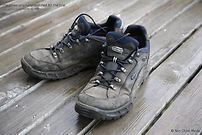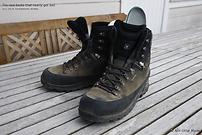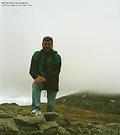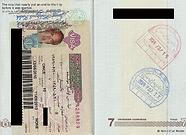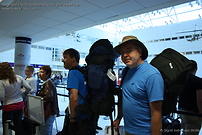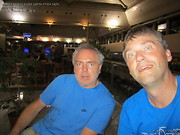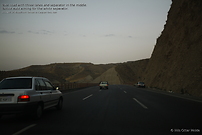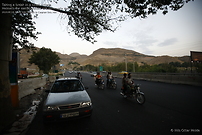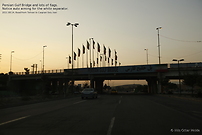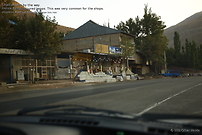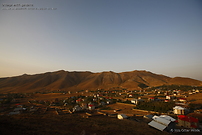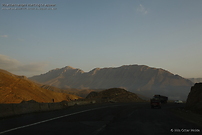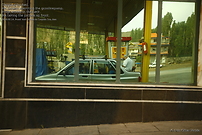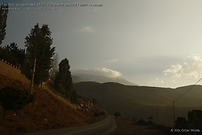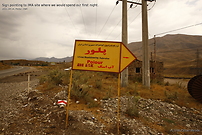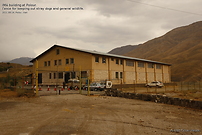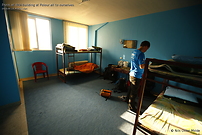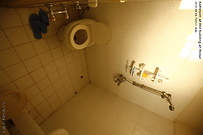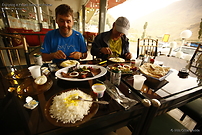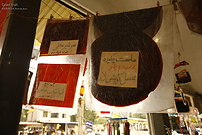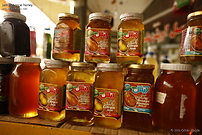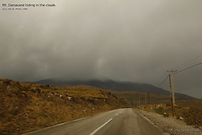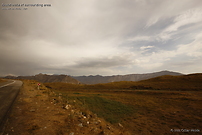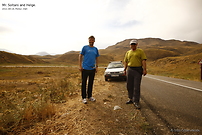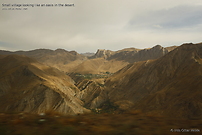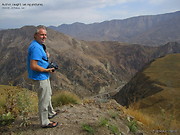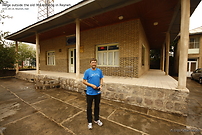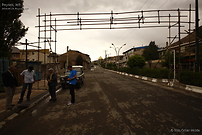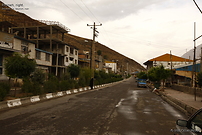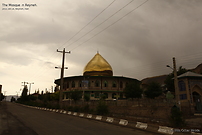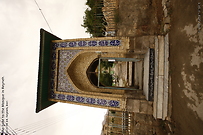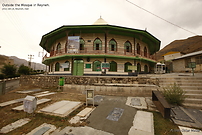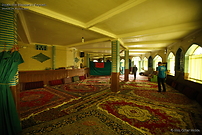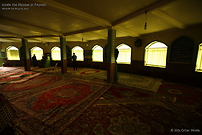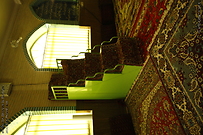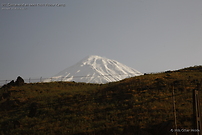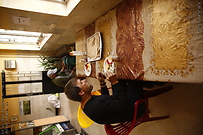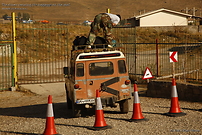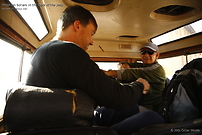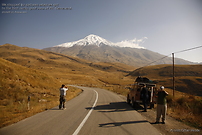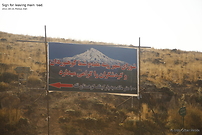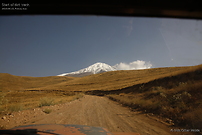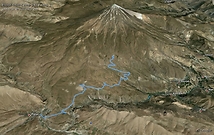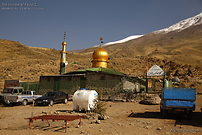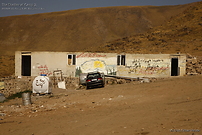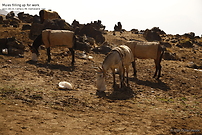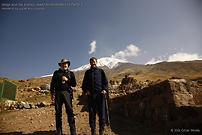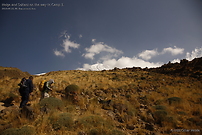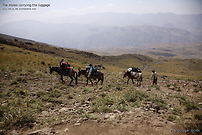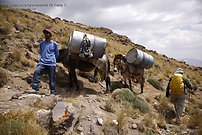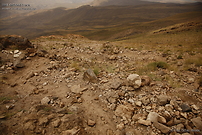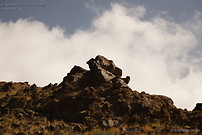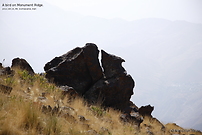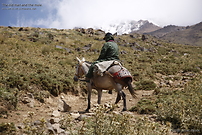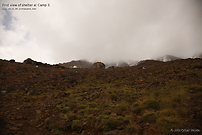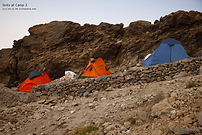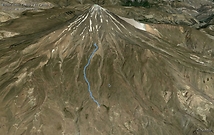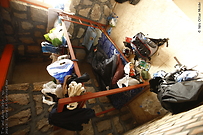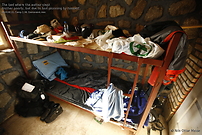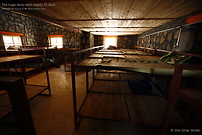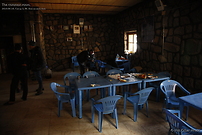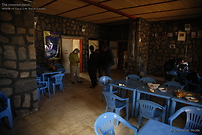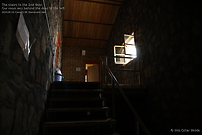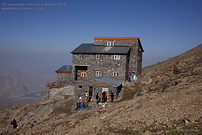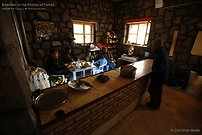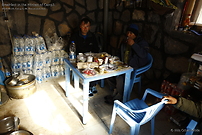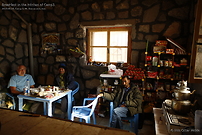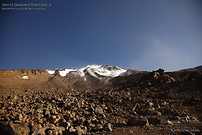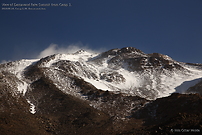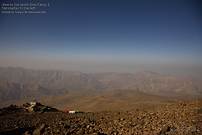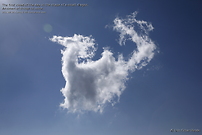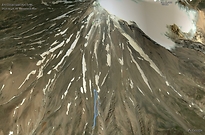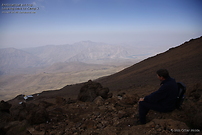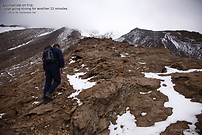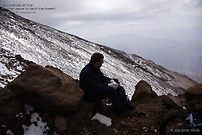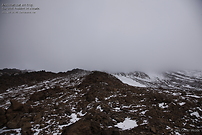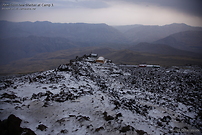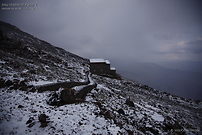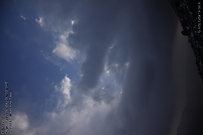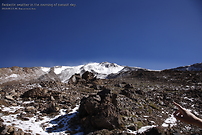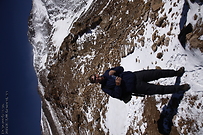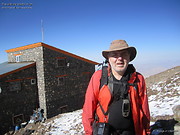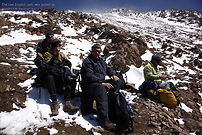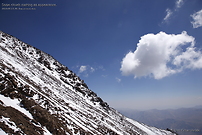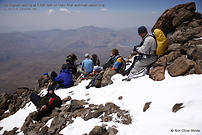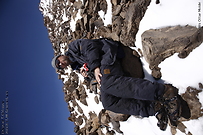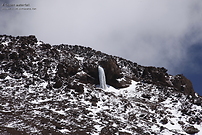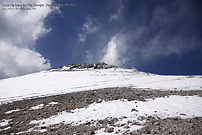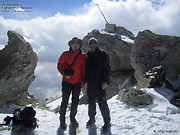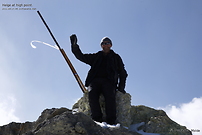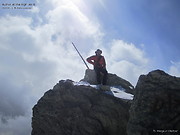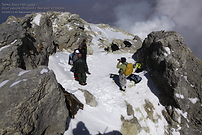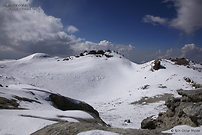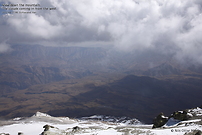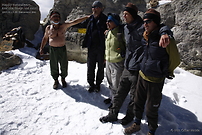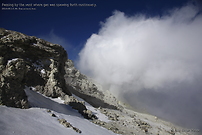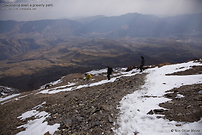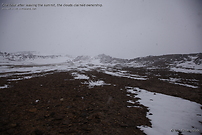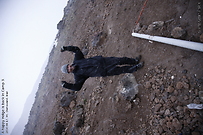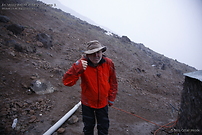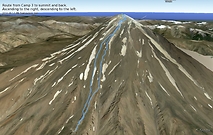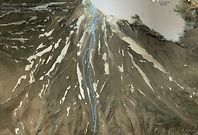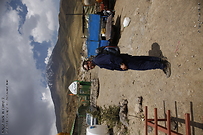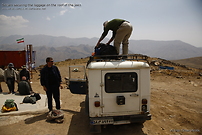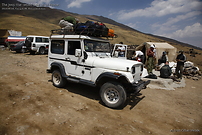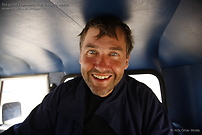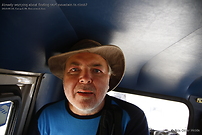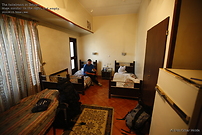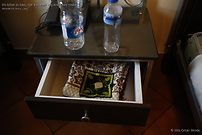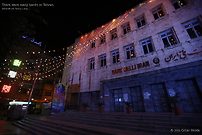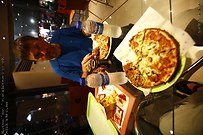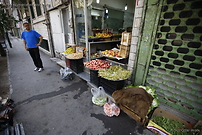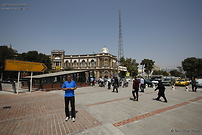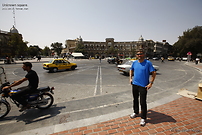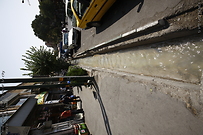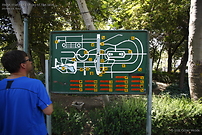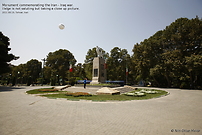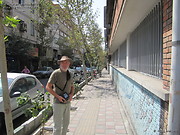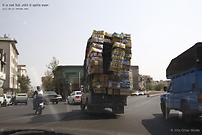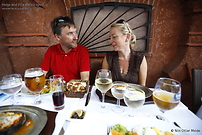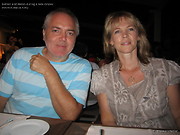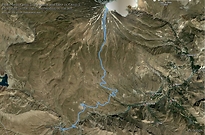Content
Preparation and a bumpy start
Departure
To the mountain
On the mountain
Tehran and departure
Istanbul
Trivia/Reference
Preparation and a bumpy start
This trip was long in the planning. The first time I planned to do this trip was with my daugther Sigrid in 2009, but both the location of the mountain and the time of realization (during the week that Sigrid was to enter a new school) proved too much for my wife. As any man of wisdom knows, do not start a battle that you can not win, and I choose to let the 2009 opportunity go.
The plan lingered in my mind though, and during the spring 2010 I put the trip proposition to one of my friends, Helge Andersen, and asked if he would like to join in a 2010 attempt. He had just figured out that he had one more week of vacation than his wife this year, and agreed almost immediately. This was during a pub round in Bergen, but I made sure to raise this at the earliest possible moment that evening, so that he could not blame a happy state of mind for a rash desicion the next day. Of course he never did, and the wheels were in motion.
How then, you may ask, did I come up with this location. The highest mountain in IRAN!?! Are there not enough mountains in the world to pick some place safe? I am of course referring to the image that is portrayed of Iran in our part of the world, Europe. The start of it all was that I had talked a bit with a former Turkish mountaineer, and he was talking warmly of climbing Ararat, the highest mountain in Turkey. As always, I consulted the pages of Petter Bjoerstad to see if he had been there. And he had. But he (and his son) had climbed Mt. Damavand on the same journey, starting with Arararat. When I read his reports, I immediately found Mt Damavand more alluring, and I changed focus.
Petter Bjoerstad had bought local services from a Mr. A. Soltani and recommended him for good work. I contacted him in 2009 and made inqueries about the mountain, and had planned a trip for me and my daugther that year when the wife put down the law. In 2010 I contacted Soltani again, and we picked up where we let go the year before, and soon had the trip outlined. Below is Mr. Soltanis itinerary based on my suggestions.
-
Day 1 - Arrival Day 14 August 2010
Arrival to Tehran, greeting you at IKA Airport, transfer directly to Camp1 Polour, just rest the day and night for acclimatization, sleep at Camp1 Polour Hut.
-
Day 2 - Starting Day 15 August 2010
Drive by car from Polour to Camp2 Base, and by 4 to 6 hours slow walk to Camp3 Bargah Sevom, sleep at Camp3 New Hut.
-
Day 3 - Acclimatization Day 16 August 2010
Ascend to nearby heights, sleep at Camp3 New Hut.
-
Day 4 - Acclimatization Day 17 August 2010
Ascend to nearby heights, sleep at Camp3 New Hut.
-
Day 5 - Summit Day 18 August 2010
Attempt climbing to the peak starting at 05:00, return back to camp3, sleep at Camp3 New Hut.
-
Day 6 - Return and Departure Day 19 August 2010
Descend down to Camp2, drive to camp1, return back to Tehran, you have some time for sightseeing in Tehran. (Transfer to IKA Int Airport and fly back to your country) Tour Ends.
In addition to this Mr. Soltani also provided the following services :
- Climbing permit fee for foreign climbers to Mt Damavand.
- Accomodation in Camp1 Polour Hut, which is a quite good lodge/hostel
- Accomodation in Camp3 New Hut, inestead of shelter/refuge Camp3 New Hut is the best place for accomedation in the area
- Transfer from IKA Airport or hotel to Camp1 Polour and back
- Transfer from Camp1 - Polour to Camp 2 Base and back
- Camp1 Hut & Camp3 New Hut charges
- Porters and mules to carry your equipments from Camp2 Base to Camp3 New Hut
- Hot meal in camps
- Lunch box during the way
- Hotel reservation in Tehran
Neither Helge (1.500 m.s.l.) nor me (3.480 m.s.l.) had been to such a height before, and we had no idea of how our bodies would react to this. Therefore I had added one extra day for acclimatization at Camp 3, conforming to the best practice : Walk high, sleep low. It would be stupid to try to shave one day off such a trip and perhaps not beeing able to reach the top.
Anyway, we confirmed the plan with Mr. Soltani, and Helge set about to order tickets for the travel from Norway to Tehran. It turned out that the best deal would be Bergen - Oslo - Istanbul - Tehran. When we saw that we would pass through Istanbul on a Friday on our way back, we asked if our wives would meet us there, and we could spend the weekend before flying home. After a bit of planning it turned out that they had opportunity to do so, and more tickets were ordered.
I was suddenly interested in the weather conditions in the Mt. Damavand area, and had an update almost every day. As the departure came closer, it turned out that it was snowing on the mountain. I had originally planned to use regular hiking shoes that did not go above the ankles, but because of this new situation I changed my mind and decided to go for mountain boots that would extend over the ankles. I wanted a particular brand, and calling round to the shops in Bergen that sell sportsgear showed that none of the stores had the brand in the size I requested. This was the Monday in the week leading up to the departure. One shop checked their store in Oslo, and could get me a pair within two days. An order was placed. Come Wednesday, the boots had arrived at the store in the center of Bergen. At the same time my daugther and her friend was arriving by boat from a vacation at her grandfathers. I drove into the town centre and collected my boots and went down to the "bryggen" to wait for the boat. When the two girls got off the boat, I collected much of their baggage and carried it to where the car was parked. The girls waited together with the luggage at the exit point of the parking lot while I went to collect the car. When I drove up, the girls came with all the luggage and put it and themselves into the car. The friend was driven to the train station, travelling on to her family, and my daugther and I drove home. When we stopped the car outside our house and collected the luggage i suddely realised that the boots were not there! The bag with the boots was left behind by the parking lot exit. The girls had not taken this bag, but only their own luggage. I threw myself into the car and drove quickly back to the parking lot. It would be at least 30 minutes since we left before I would be back. But sometimes you have more luck than you deserve. The bag was still standing on the ground where I had put it down earlier. This was a stress test on the blood pressure for sure!
We had to get visa from the Iranian authorities in order to be allowed into Iran. The summer vacation came suddenly and I went abroad without having sent in an application to the Iranian embassy in Oslo. The passport had to accompany the application, so I had no choice. Helge meanwhile sent his application, and received approved visa in just over a week. When my vacation was over, it was two weeks on the job before we were off to Iran. I promptly sendt off my application, thinking that I was well within the timeframe to receive the visa before our departure. Also the internet pages at the Iranian Embassy in Oslo stated that a reply would be sendt after a week. Well one week went by, and I started looking really hard into the mailbox on my way home from work. We were leaving on Friday morning, and it was now Wednesday, and no visa were in the mailbox at 14:00 in the afternoon. I had to take action. I tried to call the embassy, but the phone seemed to be disconnected. I called the "yellow pages", but they had no other phone numbers listed for the embassy. I called the Ministry of Foreign Affairs, and ended up talking with 4 different people, but the lot combined had only the same phone numbers as I already had. In the end I called Telenor, and asked if they could find any faults with the phone numbers, but they did not. All the time I called the numbers for the Embassy, and suddenly I got a response, and I managed to get through to the section that handeled the visas. As I explained my problem, the man on the other end rusteled papers on his desk, and found my application. He started asking me questions that I had already answered on the application. It seemed pretty obvious to me that he had not read my application at all. I felt my bloodpressure rising by the second, because I understood that time was running out fast. Luckily he was interested in finding a solution, and when I could provide the phone number for Mr. Soltani, he said that he would have a final check with him, and, if this turned out ok, he would have the visa ready by 11:00 the following day. Now, that would be Thursday, and much too late for sending the visa/passport via mail. I asked if it would be ok if I could get a friend of mine to collect the visa at the embassy in Oslo the following day? He could then send the visa to the police station at Gardermoen, and I could pick it up on Friday when passing through on my way to Istanbul. This was OK. I just had to mail him the name of my friend, and my friend would have to carry identification to match my mail, and he would get the visa and passport. My heartbeat was nearly back to normal. I quickly rang the police station at Gardermoen, and asked if it would be OK if they received a passport on Thursday, and kept it until friday morning. The officer answering the phone was extremely service minded, and would arrange for this, no problem. The only step he was worried about was that I explained that my friend would send the visa/passport with a carrier service. He preferred that my friend travelled from the embassy to the police station himself, making sure that the passport did not dissapear on the way.
Next step was to call Rolf Oeystese, and ask if he had the time to help me out. He was willing to do so in an instant, and I e-mailed his specifics to the Iranian Embassy. The next day, early in the morning, Rolf called me with some uncertanity in his voice. He had driven past the embassy on his way to work, just to make sure that he knew the location. There he read on the entance, a sign that said that office hours where from 09:00 - 11:00 Monday, Wednesday and Friday. Not Thursday. And there were no sign of people anywhere. Rolf har tried to ring the bell, but no answer at all. Suddenly I was back in anxious mode, and tried feverishly to recall the conversation I had had yesterday with the Iranian official. I was pretty sure that he had said THE DAY AFTER, which meant Thursday. I tried to call the Embassy, but no answer. I tried to e-mail the official I talked to, but no answer. There was nothing to do but wait ...
Finally at 11:15 I got a new call from Rolf who could announce that he held the visa/passport in his hands! He had been a bit early, and showed up at 10:35. Now there were signs of people at the embassy, and when he rang the bell, an Iranian had opened a window, leant out and in no uncertain terms let Rolf know that "The agreement with Mr. Molde was for 11:00 o'clock". Rolf aplogized for beeing early and waited patiently for the next 20 minutes before he was given the visa/passport. Then Rolf took it upon himself to deliver the visa/passport to Gardermoen police station himself. I can only say again : Thanks a lot!
Below you can see a picture of Rolf. He is standing on the highest point in the muncipality of Fitjar, Litlasåto, 676 m. Behind him you can barely make out the highest point in the muncipality of Stord, Mehammarsåta 759 m. The picture was taken 2001.04.06. Also the much desired visa!
Departure
Finally the departure day arrived. We both had two backpacks, one big for all the equipment/clothes we needed on the trip, and one small that would be the backpack to take into the cabin of the plane as well as use when we were walking on the mountain. We both packed a bundle of Euros in cash as Mr Soltani had warned us that because of the boycott of Iran, credit cards would be of no use whatsoever inside Iran. We planned on changing an amount of Euros into the Iranian currency, Rial, at the airport. The use for Iranian currency would not be overwhelming as we had payed half of the price agreed with Mr Soltani in advance, and carried the rest in cash (Euros), to be payed upon arrival.
Apart from clothing and sleeping bag, we carried some Norwegian chocolate and some peanuts and raisins as additional provisions.
My daugther, Sigrid, accompanied us to the airport, snapping a picture of the bold adventurers standing in line for check-in.
The first leg of the trip was from Bergen to Oslo and that was pretty uneventful. At the arrival I hurried off to the police station in order to collect my passport and visa. A nice policeman checked the passport against my person and handed it over with a smile. Now nothing could stop us!
Next leg was Turkish Airlines to Istanbul. A very nice attendant secured us two of the seats with best room for our legs. We arrived in Istanbul late in the evening at 20:30 and the next flight on to Tehran, also with Turkish Airlines, departed at 23:40. We would not be in Tehran until 04:10 in the morning. The temperature in Istanbul was overwhelming at about 38 degrees celcius. We would be sitting on a chair, and still the sweat would run down our backs.
I was still wearing shorts which is my preferred mode in the summer. Before departure I had googled about how to behave in Iran, and came across an article that stated that it is not allowed for men to wear shorts or t-shirts. The issue with t-shirts was not longer in effect but no shorts! I had packed a pair of long trousers in my backpack and had planned to change in Istanbul before the final leg to Tehran, but it was so warm that I did not bother. I would delay this until we arrived in Tehran.
Then we were off for the final leg to Tehran. None of us managed to sleep, but stayed awake consuming the food we were offered and reading. The temperature when we landed was not so opressive as in Istanbul. The climate is much drier in Tehran which is on 1000 m.s.l. and far from a significant body of water as opposed to Istanbul that is situated by the sea. When we arrived I went into a lavatory before entering the passport control and changed trousers. Now there were no doubts that we were in another part of the world as the lavatory stalls revealed not the well known porcelain of a water closet, but a hole in the floor!
Because of my trouserchange we arrived last to the passport control and had a bit of a wait as the persons checking the passports did a thorough job, but eventually we were allowed through with a minimum of fuss. Getting into the departure hall to collect our backpacks we could see Mr Soltani standing in the reception area holding a sign with the name Nils Ottar written. He immediately understood that we were the persons he waited for and we waved at each other. We now had to x-ray our baggage one more time to be allowed to leave the arrival area and enter into Iranian territory. This was a new experience, but we happily applied ourself to the test as we had nothing to hide.
Then we met Mr. Soltani face to face for the first time and handshakes and greetings were exchanged. Soltani showed us a place where we could change Euros to Rials and Helge changed 100 Euros into Rials. This proved to be much much more than we managed to spend during our stay.
We then went into the car park in order to find Mr. Soltani's car. It was a car of about the size of a VW Golf, and we stuffed our backpacks in the trunk and ourselves into the car. It was still late at night, and it was dark as we started our journey from Tehran to Polour which would be our first place to stay this day and next night.
To the mountain
As we started driving from the airport a huge construction loomed out of the dark to the right of the road. This, Soltani explained, was the tomb of Ayatholla Khomeini. It was a vast palace with many huge domes. The contruction was still going on at the place.
The traffic on the road was pretty dense at this time in the morning (05:00), but after Soltani told us that Theran had a population of 15 million citizens, it made more sense. We drove past Tehran well outside the city centre. As the light got better, I managed to make out a huge mountain in the distance to the north of the city. Just as I was about to ask Soltani if this was Mt. Damavand, he told me that we could now see our goal. Helge at this point had fallen asleep in the back of the car, while I, in the front, was far to excited to sleep.
As we left Tehran behind, we started on the main road from Tehran to the Caspian sea. The road was well maintained and differed from 2 to 5 lanes in each direction. Several places the road was beeing expanded, and sometimes we felt that we were driving along an airfield strip. The landscape we drove through was rather barren and looked to be composed of gravel and sand. Beeing a huge producer of oil, and having gravel everywhere, I guess that producing well maintained roads would be a very simple task indeed.
I had heard that the driving in Iran was rather wild, but as we drove along, the flow of traffic seemed pretty ok. The one thing that was a bit funny though was that it looked as if almost everybody was aiming at having the white stripes on the road, separating the lanes, at dead center of the car. Coming into Tehran on our way back would give us another impression of how the Iranians took to the streets with their vehicles, but more of this later.
As the sun rose, we had many vistas along the way. Most of the landscape looked like desert, but around the villages a lot of trees and gardens could be seen.
After about 3 hours we were at the village of Polour (2000 m.s.l.) where we would spend our first night in the building of the Iranian Mountain Federation.
We were given a room with two bunk beds and adjoining bathroom. This was luxury, but there were not many other people on the site at the time. The rooms left something to be desired when it came to beeing clean, but, hey, we are men of the world and can cope with a little dirt. We were just happy that our wives did not accompany us! The bathroom even had a porcelain seat instead of the hole in the floor.
After we had installed ourselves, Soltani proposed that we drive down to Polour centre for lunch. We decided on kebab, and off we were. When we came to the restaurant, we were given the option if we wanted to sit on chairs at a table, or on a slightly elevated platform filled with carpets and cushions. We decided on the chairs, afraid that if we were to sit cross-legged or in an awkward position on the carpet for the length of a meal, we would not be able to raise ourselves to the feet afterwards. Soltani just shaked his head, and we sat down on the chairs. Soltani ordered beef kebab and chicken kebab. This was very good stuff, and we also found ourself ordering alcohol free beer. This turned out to be a common beverage in Iran, but of course no alcohol whatsoever. Accompanying the dish was a platter of thin bread. This turned out to be an ingredient at all the meals served in Iran. All, and I mean all, meals were accompanied by this kind of bread. It was a cross between the Norwegian "flatbread" and the Indian Nan bread. More soft than the "flatbread", but not as tasty and thick as the Nan bread.
Just off to the side of the restaurant there was a shop, displaying goods. We saw some "sheets" of an unknown substance hanging from lines outside the shop and we guessed that it was dried meat. Soltani could explain that is was dried fruits, more like jam spread out thin and preserved between plastic. He quickly got over to the shop and brought back samples of the dried fruit. It tasted a bit like jam but perhaps not so sweet. It was rather good, and Soltani promptly bought a sheet of dried fruits for me. They also sold traditional jam and local honey. Several places as we travelled in this area we would come across sites where lots of bee hives were deployed.
After lunch Soltani proposed a trip along the foot of Mt Damavand in order to visit the city of Reyneh where the first Iran Mountain Fedration camp was located. Polour now had the most traffic, but some people still used this camp as starting point. As we drove along, the upper part of the mountain was now completely hidden in clouds. Soltani explained that this was a bit unusual at this time of year, but that the season with snow and bad weather looked to be coming a bit early. This would make for some tough desicions later on, but for now we were happy in our ingnorance of what the information Soltani produced implied for our attempt at the summit. We stopped for many foto sessions along the way.
When we entered Reyneh we pulled up outside a much smaller building that was the old IMA house. We went inside and looked around and had a chat with the proprietor.There were many pictures on the wall of people who had died on the mountain, including relatives to the young man who ran this house. Many old-timers came along and talked with us. They had all been guides to the mountain and seemed happy to be able to tell their stories. Outside we looked around the tiny village, and noticed a Mosque. We walked over and had a look. What was very unexpected was the fact that there were graves outside the Mosque, and there were so many of them that it was not possible to get from the gate to the main building without stepping on them. I thought that stepping on someone (in effigy or real) was the worst insult possible in this part of the world. There was not a prayer going on, so we took off our shoes and went inside the Mosque. The space inside was divided into two parts, one for men and one for women.
After this we travelled back to Polour camp, and had a quiet evening with some reading before we went to sleep.
On the mountain
The next day we were up early and packed for a rather long leg when it came to elevation. We were to be driven from the Polour camp to Camp 2 at 3.000 m.s.l., and walk from there to Camp 3 at 4.200 m.s.l.. This was an elevation of 2.200 meters in one day. As we looked out of the door, this was a bright clear day, and the top of the mountian was in plain sight. There looked to be quite some snow on the mountain.
After packing we had breakfast in the hall, consisting of fried eggs, tomatoes, bread and juice. Meanwhile a jeep and a driver appeared outside, and our backpacks were secured on the roof. Helge and Soltani sat in the back, while I sat in the front with the driver.
After a while we turned off the main road into a dirt track that would take us to Camp 2. I managed to snap one picture before I had to just hold on in order to not knock my self out from the jumping around of the car.
At Camp 2 mules were ready for carrying the heavier backpacks to Camp 3. We only brought our food and water for this trek in the backpacks we carried. Soltani dealt with the mule drivers, while Helge and I had a look around. There was a Mosque and a shelter and not much else except for the mules. What came as a surprise was that there were parked ordinary cars at the Camp. How they managed to drive all the way up the dirt track without messing up the cars boggles the imagination.
At this point I must admit that the height of the mountain started to get to me. Looking up to the snowy upper slopes I realized how far we had to go, and I was suddenly very glad for having an experienced guide in Soltani by our side. He had been to the top of Damavand no less then 109 times. If he managed to get us to the top as well, he would be having a mini jubilee with 110 successful ascents.
Expedition of the backpacks was quickly done, and we were ready to go.
As we started walking Soltani took the lead and set the pace. Helge and me were surprised at the pace that Soltani dictated. It was SLOW! And small, small steps. I had read a lot about walking high on the mountains, and knew that the secret of not beeing sick was to move upwards at a moderate rate, but this was almost unnatural slow. Anyway, we were not experts, and followed obediently behind Soltani. As it would prove later, Soltani obviously knew what he was doing.
We walked along a ridge that was called "Monument Ridge" because of all the formations that could be imagined into familiar shapes. Below is "The Camel" and "The Bird". The trail was well defined and made for excellent walking. It got gradually steeper but not uncomfortably so. During the whole trip, the trail would not be difficult to hike. We met several parties coming down. Mostly Iranians, but a group of three Swiss and a German. None of these had made it to the top because of the badeather yesterday. The highest some had made it was 5.000 m.s.l.. Not too many enthusastic greetings or smiles. The German had to go down because he became sick at Camp3. He had gone up earlier today, but had walked too fast and experienced severe headache and loss of appetite. So this was his attempt at Damavand.
An old man on a mule overtook us. More of him later. Nearly 5 hours after we started we got our first view of the shelter at Camp3. This building was only two years old, and a very nice building indeed. Below the new shelter there were terraces where it was possible to raise tents. When we came up there were less than 10 tents on the site. As you can see from the pictures, the weather had deteriorated a bit and there were now clouds and fog on the mountain.
We used 5 hours on our ascent of 1.200 m. This was slow, but the upside was that we were not tired at all. We were given one room with two (double) bunk beds for our stay at the shelter. Another luxury! There were several rooms with four (double) bunk beds, and one huge dorm. Also a huge common room, and a kitchen where you could buy a limited array of goods. We made us comfortable on our room, and soon we were summoned to the kitchen for some soup and bread. We were given as much water as we wanted from the kitchen. This was bottled water brought up by the mules. There was outside the shelter a pipe from a stream further up the mountain giving water continously. Or nearly continously. During the night the pipe would freeze, so in the morning there was no water, but during the early morning the sun would thaw the pipe and water would start to flow again. I drank from this water also, and it tasted fresh and good.
During the evening both Helge and I would experience headache. We drank a lot of water, and the headache went away after a short while. We decided to go to sleep early. The generator at the shelter was out of function, so there were no electricity. We had brought headlights, so we had no problem with getting around. For toilet facilities, a building beside the shelter was the place. This was a row of small stalls with the famous hole in the floor.
Now I met the first hard part of the trip, and I mean HARD. The bottom of the beds were just wooden planks with a woolen blanket on top. Neither Helge nor I had thought of bringing some kind of mattress to sleep on. Luckily Soltani found us some thin mattresses to put on top of the planks. Also, this is a shelter, not a hut as we might think of the huts provided by DNT in Norway. This means that there is no heating in the shelter whatsoever. I had taken the my wife's sleeping bag because it was the newest. Helge had shortly before this trip bought a new sleeping bag designed for temperatures down to -18 degrees celcius. So I just undressed and got into the sleeping bag in nothing but my shorts. After 30 minutes I had to admit defeat, and got up and pulled on woolen socks, woolen leggings and woolen jumper. Into the sleeping bag again. Within another 30 minutes I found myself up again, getting the blanket from the above bed and laying it on top of my sleeping bag. Finally I managed to go to sleep. But I woke many times during the night, and because of the hard surface, back pain gradually got its grip on me as well. Helge slept like a log throughout the night. In the morning I had a headache again. This is a rather common condition as we tend to breathe more shallow in our sleep. Getting water to drink relieved me of the headache within one hour.
At about 09:00 Soltani asked if we would have breakfast, and we were ready for some food. The breakfast consisted of cucumbers, tomatoes, cheese, pineapple, dates, juice and the omnipresent bread. We were served in the kitchen. Soltani really made sure that we were comfortable.
As you can see from the pictures I had not packed a fleece jacket for wearing inside the shelter. So while the rest of the people are heavily dressed, I'm waltzing around in a t-shirt, never quite warm.
This was our first day for acclimatization. We had planned for a short walk up the mountain during the day. After breakfast I went out to look around and take some pictures. The weather was fantastic as it always were in the morning. Looking up the mountain it looked formidable but exciting. From where we were standing the highest point we could see was named the "Fake Summit". The real summit was another 250 m higher behind this point. The area from the fake summit to the real summit was called the "Danger Zone". This was the area where most people died on this mountain. Last year four people out of a party of five had died there. The danger lay in the fact that from the Fake Summit and onwards, this was a featureless gravelly slope. So if you got caught on the summit while clouds, fog or snow set in, it was terribly hard to navigate this area and find back to where to descend. Many people went in the wrong directions and would go over cliffs or wander into small glaciers with crevasses.
After a while we started out for our trip. The goal was to reach at least 4.700 m.s.l.. As you can see, the clouds had started closing in, and the sun was gone from the mountain. It would get worse. We had the pace from yesterday fresh in memory, and decided to use the same pace for todays trip. We started out in what we tought was SLOW. But after only 15 minutes we were breathless and had to take a break. This continued for the whole trip. Every 15 minutes we were out of breath, and had to have a break. We carried plenty of water and made sure that we drank a lot. The clouds kept coming in, and when we turned around after nearly reaching the height we aimed for, the summit was completely hidden.
After the trip we rested on our room, reading and drowsing. The weather got steadliy worse. It started to rain, and soon the rain turned into sleet and snow. To top the evening a thunderstorm also lumbered in. As I was standing in the shelter looking out, a bit to cold for comfort, I experienced the low point of the trip. The weather forecast for the next two days were not favourable, and it was no way that I would consider starting for the summit in such weather as we experienced now.
It stopped snowing, and I put on clothes and took a trip out in order to walk about and get warm before I should jump into bed, having the trouble of getting warm yesterday night fresh in memory.
Two people had gone to the summit that day. They had started really early at around 06:00 so they were back before the worst of the weather set in. It was one from Poland and one from China. Also that evening a batch of about 10 Englishmen came to Camp 3. They planned an acclimatization trip to 5.000 m.s.l. the next day. A couple of Iranians also came up, and one of them had to be helped down again because he got ill. Headache and nausea. The remaining Iranians put up a tent, but later in the evening they came into the shelter becasue of the cold. On the pictures above you can see the snow on the ground.
Since we only planned for a acclimatization trip for the next day too, we did not rise until 09:00. The weather was excellent as usual in the morning. We talked about todays trip with Soltani at breakfast, and he said that he would accompany us. He also said that we ought to pack for a summit push, and that if the weather was ok when we reached 5.000 m.s.l., and we felt fine, we ought to try for the summit. The weather forcast for tomorrow was not favourable, and we had fresh in mind what had happened yesterday. We did not start out from Camp 3 until 11:00 which was very late compared with the recommended time of start for a summit push, about 05:00 - 06:00.
We did not know if anybody else was attempting a summit push today, we only knew about the group of Englishmen that was going for 5.000 m.s.l.. As we started out Soltani took the lead, and we now immediately understood why Helge and I had been exhausted after only 15 minutes yesterday. This was SLOW! Although we had tried for a slow pace yesterday, we had not managed to go so slow as we ought to. At Soltanis pace we only had a pause for each hour of walking and had no (major) problems with walking for 60 minutes as opposed to 15 the day before. After nearly one and a half hours we saw two persons starting out from Camp 3 in a terrible tempo, and within one hour they had cathed up with us. We stepped aside for them to pass, but they must have understood that they were going much too fast, and asked if they could walk with us. Soltani said it was for Helge and me to decide, and we of course agreed to their request. They were two young Englishmen that had come to Camp 3 the day before. They would attempt the summit without a day of acclimatization.
It was much heavier going than the trip from Camp 2 to Camp 3. This was due to the height, as we had to concentrate on our breathing all the time, and the fact that there now was snow underfoot, making the trail slippery and more difficult. Soltani really had a hard job taking the lead all the way, making the initial track in the snow.
When we had breaks Soltani made sure that we drank and ate. When Soltani felt that the break was over over, he always asked "Shall we go?", but you knew that it was not a question, but a command, said in the most polite way possible.
At 5.000 m.s.l. we caught up with the group of Englishmen who were having a good rest before descending to Camp 3. The weather was good and we all felt strong, so the desicion to continue was easily taken. The only discomfort we had was the feeling of not getting enough air. Because of the slow pace, we never got tired in the feet, but only felt a constant craving for more air. You had to concentrate on breathing all the time.
I had sunglasses in my backpack, and all the time when we were walking I thought that the next time when we have a break, I must remember to put them on. Every time we had a break I was busy breathing and drinking, and forgot all about the sunglasses. This kept on repeating itself many times.
After another couple of 100 meters we came upon the old man that had passed us on the way to Camp 3 riding a mule. He was greeting us in his native tounge, and talked like a torrent. He decided to join our group, and kept up a steady stream of conversation all the way to the top. I found that amazing as I had no breath left for talking. It was quite a feat.
We also noticed a figure below that gained on us at an alarming rate. As he drew closer, it turned out to be a young Swiss. He looked like he was having a walk in the park. One hand nonchalantly tucked in his trouser pocket, and in the other hand carrying a plastic bag. He did not have any head gear at all. And ascending at an, to us, inhuman pace.
We had another break just after passing the "Fake Summit", and looking into the danger zone. I had not noticed that we had passed the "Fake Summit" and tried to cheer up the other with pointing to the real summit, and saying in an optimistic tone; "When we pass this fake summit, we only have 250 metres left.". They fell over themselves telling me that I was now pointing to the real summit. The one ending up beeing noticably in a more happy state of mind was myself when I realized that I was 250 metres higher than I thought.
After the trip I noticed that I had not taken any photos after 5.000 m.s.l. and until we came to the top. Also I had a GPS hanging around my neck and could check the altitude at any time I wished. Combined with the error in judgement of where we were it tells that my main concern was of getting air into my body, and my mind not beeing the razor sharp instrument it usually is (lol). I never felt dead tired, or that my stamina would expire, but a huge lot of effort and concentration went into breathing. The photo above was taken on the way down.
As we zig-zagged up the final slope to the top, the Swiss just aimed straight for the top and strolled along as if he was walking in his own living room. We passed close to the vent where a huge stream of sulphuric gas pured out, and we had to wait until the wind was favourable before we hurried past. We could not escape the gas completely, and while not dangerous, it smelled really bad, and was not pleasant when you struggle to get as much air into your lungs as possible.
As we passed memorable height during the ascent, Soltani would point out to us what mountians we were now matching, and surpassing, in heigths. He noted :
- Mont Blanc (France/Italy) 4.808 m.s.l.
- Ararat (Turkey) 5.165 m.s.l.
- Everest Base Camp (Nepal) 5.360 m.s.l.
- Elbrus (Russia) 5.642 m.s.l. (Highest mountain in Europe)
Finally we were at the top, and there were smiles all around! Soltani prepared a small ritual where we all thanked the mountain for letting us go to the top. We had used 6 hours from Camp 3 to the top. The ascent was 1.400 meters, so no records were broken, but, again, we never got so tired at any point of the trip that we just wanted to quit, and we never suffered from headache or feeling sick. One of the Englishmen had a rather fixed look on his face and was awfully quiet. He told us the day after that he had had a tremendous headache at the last part of the ascent and well into the descent, but they had one less day of acclimatization, and they had started out the two first hours today at a break-neck speed, so this was not unexpected.
We set out to take some pictures, and everybody wanted pictures of themselves at the top. The actual high point was a couple of metres higher on some boulders/cliffs right beside the site where we had stopped, and where I suspect all that comes to the summit stops. I had to get to the top of this cliff, and went right up there. Now I could see into the crater, which is rather tiny, and the rim all the way around. Helge took my picture when I was at the high point, and when I got down he went up there as well, and I got his picture. I do believe that we were the only two who made that mini-effort to actually stand on the high point.
The old man impressed everybody by stripping to the waist, and still talking like there were no tomorrow. Soltani said that he was over 70 years old, and had been to the top of the mountain once every year since he was 16 years old.
After about 15 minutes Soltani told us all in no uncertain terms that we needed to get our stuff together and start descending. We were at the top very late in the day due to the late start in the morning. We all had experienced the degrading of the weather in the evenings the last days, so we did not argue with this desicion. Now the time was 17:00, and the sun was still shining, so we were tremendous lucky to summit in this window of favourable weather.
When we started downwards, we would take a path slightly to the left of the ridge we came up, This was a path down a gravelly slope all the way down. It would be a bit steep at times, but it was pretty easy to go down as we would slide gently in the gravel and snow. We did not walk for more than an hour before the clouds came over the summit and it started to snow. Luckily it did not snow so hard as it did the evening before.
The descent was done in 3 hours, so we were back at Camp 3 at 20:00, 9 hours after we started, as it started to grow dark. It was very good to be back down, and I was frankly amazed that we had not experienced any altitude related discomfort apart from feeling continously out of breath. Even when standing still ...
Helge and I went straight for bed without supper. Helge soon drifted off to sleep in his new sleeping bag. I spent at least one hour shivering from cold before I drifted off to sleep. Another uncomfortably night with back pain was in store for me, but I had no one else to blame than myself. I keep forgetting that I am not 25 years old, and that I have grown used to the comforts of the bed at home. So I should have packed an inflatable mattress, and a sleeping bag that was meant for a cold night.
The next day we rose at 09:00 and had a breakfast before we started to collect our gear and prepare for descent. We were now one day in surplus because we had summited one day earlier than planned. We would now travel all the way back to Tehran today and spend the night in a hotel there, having most of the next day for sight-seeing as our plane out of Iran was not before late in the evening.
We collected all of our unused batteries, raisins and nuts and gave them to the two persons who staffed the shelter. We set the backpacks by the entrance to the shelter, ready for mule transport. Soon Soltani asked us if we were ready, and we set out on the track down to Camp 2.
This time we were accompanied by a friend of Soltanis, a very experienced mountaineer, who had come all the way up to Camp 3 the previous day in order to help out with a summit push today if we did not make it yesterday. This was extremely service minded of Soltani, and showed again his will to make our experience the best possible. As it were, we had no use for this backup, but he had a jeep at Camp2 now, and would drive us back to Camp 1.
Below you see a picture of Helge down at Camp 2. The time is about 13:00, and the mountain is already in shadow caused by incoming clouds. Yesterday we had been at the summit at 17:00 in bright sun. No doubt we made the right desicion in going all the way yesterday. The English group would not experience such a nice climate as we did.
When we got to Polour, we had a shower, and changed to fresh clothes. Luxury! After this we packed our stuff in Soltanis car, and drove down to Polour centre, were Soltani insisted on us having a traditional meal for lunch. This was lamb and potatoes that had been cooked in small vats with lots of sauce. Also the bread of course and raw onions. First we poured the sauce out from the vats (each person got one) and ate this as a soup. Then we poured the remaining meat and potatoes on to our plates and mashed them together. It was very good.
Tehran and departure
Soltani of course knew of several hotels in Tehran, and we opted for a mid-scale alternative. We started the drive to Tehran after the meal and now as we were riding in the middle of the day, the traffic was a bit heavier. As we neared Tehran the traffic got denser and denser. Soltani told us that certain parts of the city was not permitted for private cars at given times of day/days of week in order to reduce traffic jams. People were crossing the streets in heavy traffic in what looked like very high risk operations. The cars wove in and out of lanes continously. But the one emerging pattern was that all the drivers were very flexible, and interested in keeping a nice flow. There were no drivers who forced themselves forward, there were always someone willing to yield, and nearly no use of the horns. In short; A lot less aggressive driving than you would expect at first glance.
The hotel we checked into cost 36 Euros for a double room. A very reasonable price indeed. And the minibar was huge, but empty. After a short rest we went outside to find something to eat. The area we were in turned out to be the location for the embassies, so it was a rather quiet area. Still, we managed to find a shopping mall, and a pizza restaurant. After our meal we repaired back to the hotel for a good night sleep.
The next morning Helge was really in a good mood when he woke up. He was looking forward to a huge hotel breakfast. When we entered the room where breakfast was served, there were only three other persons already present, and the table holding the food looked alarmingly small. As we closed in, the avialable food turned out to be : tomatoes, cucumbers, cheese, honey, strawberry jam, hard-boiled eggs and the usual bread. Seeing the expression of disbelief in Helge's face was priceless. Anyway, we had to do with what was offered, and tucked in. I had found the breakfasts in Iran most agreeable, and with the addition of hard-boiled eggs was more than happy.
After the breakfast we took to the streets in order to get a feeling of Tehran. We went back to the shopping mall we had found yesterday as it seemed that this was situated along a major road. We walked along this road, and soon felt like some rare animal. The pavements were packed with people, beeing composed of 80% male and 15% female and 5% children. All of them native. We walked around for about 3 hours and in that timeframe noticed only one other person that looked European. And this was in the area where the foreign embassies were situated no less. So we were of course a novel treat for all the others. Mostly people just looked at us, but some smiled and greeted us, and the most adventureous asked us where we were from. All in all an agreeable atmosphere. Worrying a bit of what would be considered a provocation, I did not take many pictures during this trip. This caution was probably uncalled for.
Ths stores carried lots of modern consumer goods. What was very odd was that the same kind of stores were always at the same location. We would walk for 100 metres with nothing but stores that sold office furnitures, then the next 250 metres would be electronics, then 150 metres with nothing but tools and workwear and so on.
We came to a park, but inside the park there were no shops that sold water or food. It looked a bit run down and would have benefited from some maintenance. It was very hot with temperatures in the upper 30s (celcius), so at the time we were looking for vendors that sold water.
The most dangerous moments of our stay in Iran also occurred in Tehran. It looked like a simple task as it was nothing more complicated than crossing a street. The street was a one way street with 6 lanes. There were pedestrian crossings clearly marked, but no vehicle seemed to notice this fact. As I mentioned earlier the Iranians seems to be of the opinion that traffic rules are nothing but a vague suggestion of how to conduct behaviour in the streets.
We stood by the pavement edge completely lost, not understanding how to get to the other side of the street. We spent some time observing how the Iranians managed to cross, and the modus operandi seemed to be just to start walking into the flow of passing cars/motorcycles. After quite a lot of natives had managed to cross without any incidents we understood that this was the only way to proceed. We positioned us to the left of the crossing, and when the next batch of people started to cross, we went into the street with them, walking at the same pace always having them to the dead right of us. The view of the oncoming traffic veering either to the left or right of us, never slowing down for an instant, is etched into my memory as a truly frightening experience. To really top this experience, as we nearly had reached the opposite pavement, a motorcycle streaked by us, missing us with a hair's breathd (at least feeling so), driving in the opposit direction! This was a one-way street so we were looking to the right all the time, taking it for granted that no one would be coming from the left. A scare indeed!
The women that were on the streets were for the most dressed in jeans, a coat and a scarf to hide their hair. There were very few who dressed in burkas.
We had arranged for Soltani to pick us up at 15:00 for transport to the airport, and after we returned to the hotel, we lay on the beds reading until he called.
The trip to the airport again showed us how clogged traffic could be in Tehran, but again, refreshingly non aggressive. The same situation in Italy would have been a continous cacopohny of honking horns, verbal and non-verbal insults.
Seeing three persons on a motorcycle was common, but the load on the truck showed below was unique. It looked as if it would probably only be a question of time before the truck would topple over to the side during a turn in the road.
We had a long wait at the airport before our plane was to leave for Istanbul. We spent the time having some food, non-alcoholic beer, reading and going over the last few days, discussing the fine details of the trip.
Istanbul
In Istanbul we arrived at our hotel, which turned out to be quite luxuriuos, early in the morning while our wives were still asleep. We went to our separate rooms for a shower and some sleep and we all met up for a late breakfast later.
The next days in Istanbul was very fun, especially as none of us had been there before. A lot of sightseeing and good food and drinks.
Travelling home from Istanbul this was the end of the most exotic travel I've had so far. So now it was home and start searching for the next great adventure. Jbel Toubkal, Elbrus, Baekdu Mountain or perhaps a nice week with the family covering the mountains that make up the "4 Peaks Challenge" in Great Britain?
Trivia/Reference
Photos marked with Nils Ottar Molde is taken with a Canon EOS-1 Ds Mark III camera, using either a Canon EF 16-35mm II USM lens or a Canon EF 24-105 1:4 L IS USM lens.
Photos marked with Sigrid Indrekvam Molde is taken with a Canon EOS 450D camera.
Photos marked with Helge Andersen is taken with a Canon IXUS camera.
A very handy reference is Mr. Soltani's web page concerning all aspects of hiking to Mt. Damavand and hiking in high altitudes in general. http://damavandmt.blogspot.com/
Here is how the GPS readings we collected during the trip is rendered in Google Earth.
And below is the kml format of the routes. Using the GPSBabel software, you could probably convert it to fit into your own GPS device.
These files can also be applied directly into Google Earth so you can view the routes from many different angles and altitudes.
Download kml file for Polour - Camp2, Damavand Base Camp
Download kml file for Camp2 - Camp3
Download kml file for acclimatization tour from Camp3
Download kml file for summit day
A note on the height of Mt. Damavand. The Iranian official maps refer to the height of the mountain as 5.671 m.s.l.. Wikipedia sets the height to 5.610 m.s.l.. The measurements done by Petter Bjoerstad and by myself during the trip, using GPS, implies the actual height to be 5.610 m.s.l.. So when Mr. Soltani told us that we were higher than Elbrus (5.642 m.s.l.) that might unfortunately not be true.
